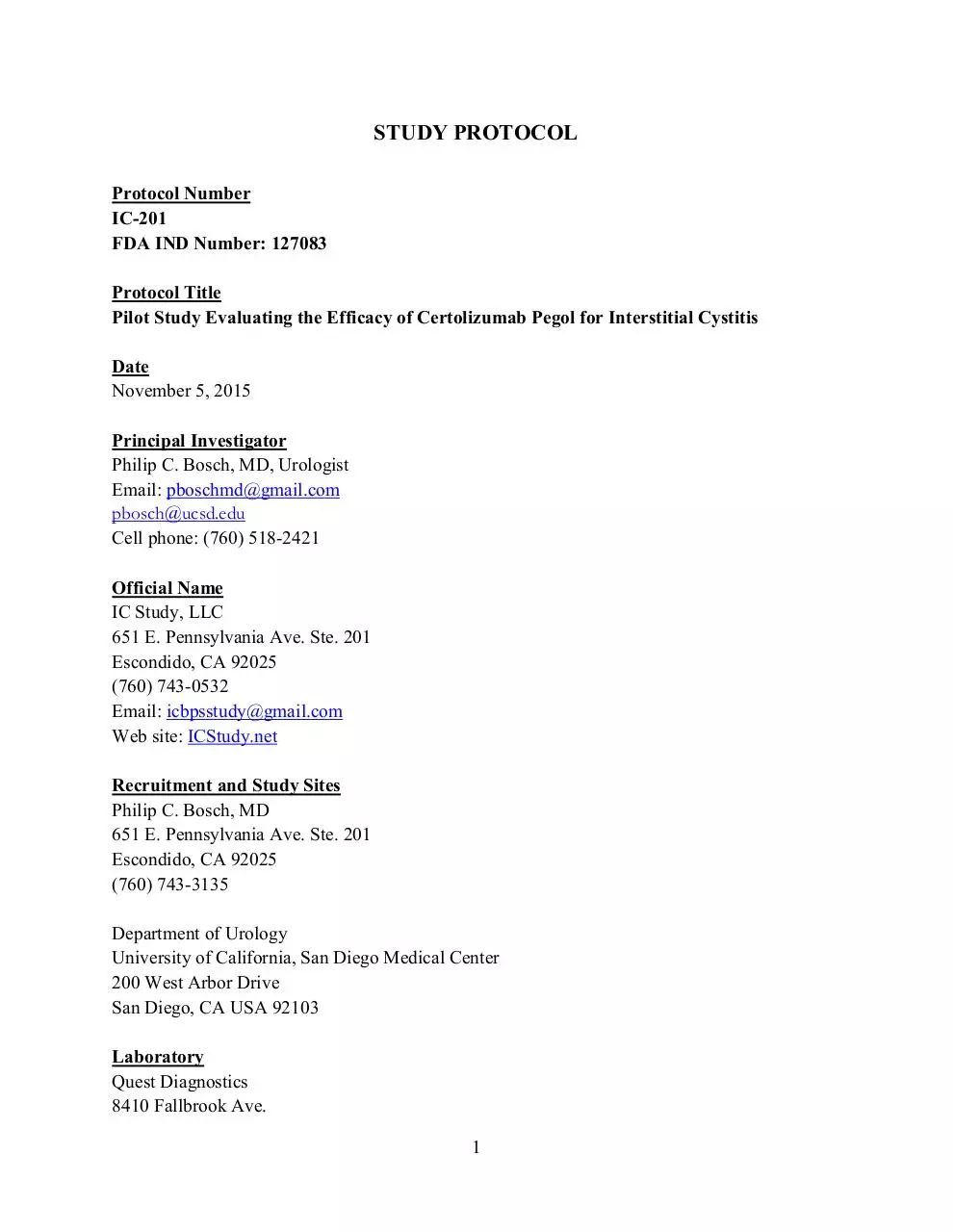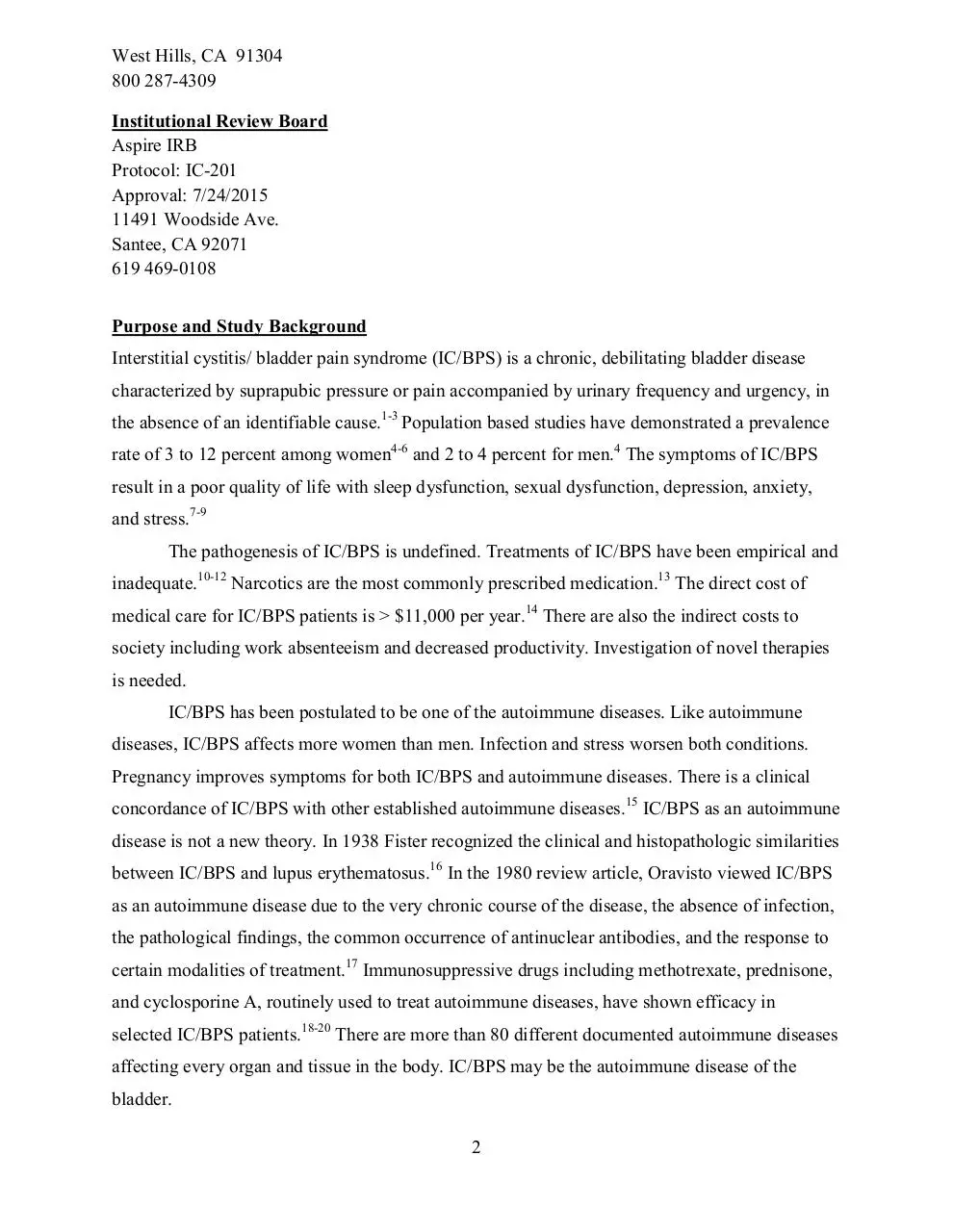Protocol Certolizumab Pegol for IC FDA changes (PDF)
File information
Author: Bosch
This PDF 1.4 document has been generated by Acrobat PDFMaker 9.1 for Word / Adobe PDF Library 9.0, and has been sent on pdf-archive.com on 24/01/2018 at 23:25, from IP address 76.88.x.x.
The current document download page has been viewed 498 times.
File size: 308.82 KB (16 pages).
Privacy: public file





File preview
STUDY PROTOCOL
Protocol Number
IC-201
FDA IND Number: 127083
Protocol Title
Pilot Study Evaluating the Efficacy of Certolizumab Pegol for Interstitial Cystitis
Date
November 5, 2015
Principal Investigator
Philip C. Bosch, MD, Urologist
Email: pboschmd@gmail.com
pbosch@ucsd.edu
Cell phone: (760) 518-2421
Official Name
IC Study, LLC
651 E. Pennsylvania Ave. Ste. 201
Escondido, CA 92025
(760) 743-0532
Email: icbpsstudy@gmail.com
Web site: ICStudy.net
Recruitment and Study Sites
Philip C. Bosch, MD
651 E. Pennsylvania Ave. Ste. 201
Escondido, CA 92025
(760) 743-3135
Department of Urology
University of California, San Diego Medical Center
200 West Arbor Drive
San Diego, CA USA 92103
Laboratory
Quest Diagnostics
8410 Fallbrook Ave.
1
West Hills, CA 91304
800 287-4309
Institutional Review Board
Aspire IRB
Protocol: IC-201
Approval: 7/24/2015
11491 Woodside Ave.
Santee, CA 92071
619 469-0108
Purpose and Study Background
Interstitial cystitis/ bladder pain syndrome (IC/BPS) is a chronic, debilitating bladder disease
characterized by suprapubic pressure or pain accompanied by urinary frequency and urgency, in
the absence of an identifiable cause.1-3 Population based studies have demonstrated a prevalence
rate of 3 to 12 percent among women4-6 and 2 to 4 percent for men.4 The symptoms of IC/BPS
result in a poor quality of life with sleep dysfunction, sexual dysfunction, depression, anxiety,
and stress.7-9
The pathogenesis of IC/BPS is undefined. Treatments of IC/BPS have been empirical and
inadequate.10-12 Narcotics are the most commonly prescribed medication.13 The direct cost of
medical care for IC/BPS patients is > $11,000 per year.14 There are also the indirect costs to
society including work absenteeism and decreased productivity. Investigation of novel therapies
is needed.
IC/BPS has been postulated to be one of the autoimmune diseases. Like autoimmune
diseases, IC/BPS affects more women than men. Infection and stress worsen both conditions.
Pregnancy improves symptoms for both IC/BPS and autoimmune diseases. There is a clinical
concordance of IC/BPS with other established autoimmune diseases.15 IC/BPS as an autoimmune
disease is not a new theory. In 1938 Fister recognized the clinical and histopathologic similarities
between IC/BPS and lupus erythematosus.16 In the 1980 review article, Oravisto viewed IC/BPS
as an autoimmune disease due to the very chronic course of the disease, the absence of infection,
the pathological findings, the common occurrence of antinuclear antibodies, and the response to
certain modalities of treatment.17 Immunosuppressive drugs including methotrexate, prednisone,
and cyclosporine A, routinely used to treat autoimmune diseases, have shown efficacy in
selected IC/BPS patients.18-20 There are more than 80 different documented autoimmune diseases
affecting every organ and tissue in the body. IC/BPS may be the autoimmune disease of the
bladder.
2
Selective release of tumor necrosis factor-alpha (TNFα) by mast cells (MC) plays a
central role in the pathogenesis and pathophysiology of IC/BPS. Bladder biopsies of patients
with IC demonstrate increase numbers of MC.21-23 A selective release or degranulation of
vasoactive and proinflammatory mediators by MC, a process called "activation", may explain
IC/BPS pathogenesis.24,25 MC activation elicits an inflammatory response in urothelial cell
IC/BPS models with secreted product TNFα playing a central role.26,27 Inflammation in
experimental IC/BPS was mediated by TNFα.26,28-30 Drugs that inhibited TNFα decreased this
experimental IC/BPS bladder inflammation. Interruption of mast cell activation, with a decrease
expression of TNFα, inhibited bladder inflammation in an autoimmune cystitis model.31
Elevated levels of TNFα in urine, serum, and tissue were found in patients with IC/BPS.
TNFα, a proinflammatory cytokine released by immune cells, is central to the acute and chronic
inflammation in autoimmune diseases.32,33 Patients with clinically diagnosed IC/BPS, but no
glomerulations observed with cystoscopy under anesthesia after hydrodistention, had elevated
levels of TNFα in urine or bladder wash fluid.34 However, patients with clinically diagnosed
IC/BPS, but did have glomerulations observed with cystoscopy under anesthesia after
hydrodistention, did not have elevated levels of TNFα in urine or bladder wash fluid compared to
controls. Interestingly, cystoscopic findings were not felt to identify distinct subgroups of
patients with IC/BPS symptoms.35 TNFα was upregulated in urine of patients with overactive
bladder36, a syndrome that has been considered a milder form of IC/BPS.37 Serum levels of
TNFα were significantly higher in patients with IC/BPS.38 Tissue levels of TNFα were
significantly elevated in women with vulvar vestibulitis.39 Vulvar vestibulitis, also known as
vulvodynia is part of the symptom complex in women with IC/BPS.40 TNFα is highly expressed
in bladder urothelium tissue of patients with ulcerative IC/BPS and was suggested to be the
causative etiology of IC/BPS.41
I recently completed a study (ClinicalTrials.gov Identifier NCT01295814) "A
Randomized, Double-Blind, Placebo Controlled Trial of Adalimumab in the Treatment of
Interstitial Cystitis/Bladder Pain Syndrome".42 Adalimumab is one of several biological agents
that are known as TNFα antagonists or TNFα blocking agents. Adalimumab is a recombinant,
fully human, monoclonal antibody that neutralizes human TNFα. In this study adalimumab
treatment demonstrated a statistically significant improvement in outcome measures compared to
baseline in patients with moderate to severe IC/BPS. However, adalimumab failed to
demonstrate positive proof of concept compared to placebo due to a significant placebo effect.
This confounding result was evaluated and analyzed in my paper “Examination of the Significant
Placebo Effect in the Treatment of Interstitial Cystitis/ Bladder Pain Syndrome”.43 The
3
conclusions of this paper were that this greater "placebo effect" represented the benefits of
advice, support, education, and behavior modification programs. The recommendation was that
physicians should review standard advice with all IC/BPS patients before starting medical
therapy or clinical trials. Future studies should include a washout period after subjects receive
standard IC/BPS advice. Only those patients who do not improve with standard IC advice and
therapy would be participants in clinical trials.
Current understanding of the TNFα blocking agents recognizes differences in each of
their mechanism of action and clinical experience. Adalimumab may not theoretically be the best
TNFα blocking agent for the treatment of IC/BPS. Adalimumab mediates complementdependent cytotoxicity and antibody-dependent cell-mediated cytotoxicity. Adalimumab
increases the proportion of cells undergoing apoptosis and the level of granulocyte
degranulation.44 This may not be therapeutically beneficial as IC/BPS histologically
demonstrates a pancystitis with mast cell infiltration.45 A total degranulation of these
inflammatory cells with the release of histamine, cytokines, and proteolytic enzymes, typical of
an anaphylactic reaction, may exacerbate bladder inflammation.
Certolizumab pegol (Cimzia) has some advantages over other TNFα blocking agents for
the treatment of IC/BPS including better distribution in inflamed tissue46, development of low
levels of neutralizing autoantibodies47, greater affinity to TNFα 48, and efficacy when used in
monotherapy49. Patients with rheumatoid arthritis treated with certolizumab pegol demonstrated
a rapid clinical response, often within 2 weeks. Certolizumab pegol inhibits cytokine
production.44 Certolizumab pegol has a unique mechanism of action that should be beneficial in
the treatment of IC/BPS in that it has no complement-dependant cytotoxicity and antibodydependant cell-mediated cytotoxicity.44,50 IC/BPS histologically demonstrates a pancystitis with
mast cell infiltration.45 The polyethylene glycol moiety of certolizumab pegol inhibits mast cell
degranulation.51 TNFα blocking agents that do not cause cytolysis and prevents degranulation of
these inflammatory cells should be therapeutically beneficial in the treatment of IC/BPS.
Most trials in IC/BPS use a patient-reported global response assessment (GRA) such as
“Compared to when you began this trial, how would you rate your IC symptoms now?” as the
primary endpoint.52,53 The O'Leary-Sant Interstitial Cystitis Symptom Index and Problem Index
(OSPI) questionnaire evaluates overall symptoms in IC/BPS patients.54 The OSPI results
confirm the clinical diagnosis of IC/BPS and establish the severity of the participants IC/BPS
baseline symptoms. The Interstitial Cystitis Symptom Index (ICSI) is one of the two O'LearySant Interstitial Cystitis Symptom and Problem Indexes. ICSI has been validated as a reliable
4
and responsive measure of changes in IC/BPS symptoms.53,55 ICSI is recommended as an
endpoint in IC clinical trials.
Research has searched unsuccessfully for an inflammatory urine biomarker for the
diagnosis of IC/BPS. However, Felson34 demonstrated elevated urine TNFα levels measured by
ELISA in patients with IC/BPS compared to controls. It would be interesting to measure urine
TNFα levels with modern techniques in IC/BPS patients and see if those levels go down with
certolizumab pegol treatment.
The FDA asked for more outcome measures so ICPI and numeric rating scale for pain
and urgency was added. They asked for monitoring of patient with outcome data to week 18. We
also agreed to change the potential total number of patients from 44 to 42 as this would maintain
the 2:1 study medication ratio.
Condition
Intervention
Phase
Cystitis, Interstitial
Biological: Certolizumab pegol (Cimzia) Phase III
Bladder Pain Syndrome
Other: Placebo
Study Type:
Interventional
Study Design:
Randomized, Double-Blind, Placebo Controlled Treatment, Efficacy Study
Primary Outcome Measures
The primary endpoint is improvement in global response assessment (GRA) at week 2
Secondary Outcome Measures
Improvement in GRA at week 4, 10, and 18
Improvement in the Interstitial Cystitis Symptom Index (ICSI) Interstitial Cystitis Problem Index
(ICPI) from baseline to week 2, 4, 10, and 18
11-point numeric pain and urgency scale at baseline, week 2, 4, 10, and 18
Midstream first void urine specimen level of TNFα normalized to urinary creatinine, at week 2,
4, 10, and 18 compared to baseline levels
Adverse events from time of Screening through the last clinic and phone call visit
5
Estimated enrollment
42 patients
After subjective evaluation of efficacy and safety in the initial 30 patients, the total study sample
size will be 42 study patients.
Previous IC/BPS studies demonstrated an approximate 20% placebo response rate.56
Monotherapy response rate of certolizumab pegol in rheumatoid arthritis was 45%.49 To achieve
an 80% power using 2:1 randomization and a 2-sided p = .05 a minimum of 39 subjects was
required. The sample size was increased by 3 subjects to account for potential participant
withdrawals.
Arms
Assigned Intervention
Group 1:
Biological: Certolizumab pegol (Cimzia) 400 mg pre-filled syringe loading
Experimental
dose given subcutaneously at week 0, 2, and 4 followed by a maintenance
dose at week 8
Group 2: Placebo
Placebo: given subcutaneously at week 0, 2, 4, and week 8
Comparator
Eligibility
Ages Eligible for Study: 18-65
Genders Eligible for Study: Female
6
Inclusion Criteria:
1. A diagnosis of IC/BPS defined based on AUA guidelines as the following: an unpleasant
sensation (pain, pressure, discomfort) perceived to be related to the urinary bladder,
associated with lower urinary tract symptoms of more than 6 months duration, in the
absence of infection or identifiable causes, documented history or patient reported.
2. Only those patients with moderate to severe IC/BPS will be included in the study.
3. Able to provide informed consent to participate in the study and comply with study
requirements
4. Able to provide written authorization for use and release of health and research study
information
5. Written documentation of being provided California’s Experimental Subject’s Bill of
Rights
6. Females ≥18 and ≤ 65 years of age previously diagnosed with interstitial cystitis/ bladder
pain syndrome (IC/BPS) for a duration of greater than 6 months
7. Female patients of child-bearing potential must have a negative serum pregnancy test at
Screening and use birth control while in the study.
8. O'Leary-Sant Interstitial Cystitis Symptom and Problem Indexes (OSPI) score ≥ 18
9. No history of any cancer.
10. No bacterial cystitis in previous 1 month
11. No active herpes in previous 3 months
12. Never treated with cyclophosphamide
13. No neurogenic bladder dysfunction (due to a spinal cord injury, stroke, Parkinson’s
disease, multiple sclerosis, spina bifida or diabetic cystopathy)
14. Absence of bladder, ureteral or urethral calculi for previous 3 months
Exclusion criteria:
1. Symptoms are relieved at one month reevaluation visit after receiving IC/BPS behavior
modification advice at screening visit.
2. Symptoms are relieved by antimicrobials, antibiotics, or other medications for IC/BPS
3. Pregnant women, lactating mothers, nursing mothers, women suspected of being
pregnant and woman who plan to be pregnant during the course of the clinical trial
4. Males
5. Patients with inadequate renal, hepatic, or cardiac function
6. Patients with history of gross hematuria within 2 years.
7. Patients with the following medical history: Lower urinary tract anatomical anomaly,
pelvic radiotherapy, or active genital herpes
8. Patients with a history of tuberculosis (TB), recent exposure to TB, or recent travel to TB
endemic regions. Patients should have a recent negative PPD (or negative CXR) prior to
receiving treatment.
9. Patients who have undergone cystoscopy under anesthesia with bladder biopsy,
hydrodistension, or fulguration of Hunner's ulcer within 3 months
10. Patients taking the following treatments for interstitial cystitis at Screening: Intravesical
BCG, corticosteroid therapy, cyclosporine, or TNF-alpha inhibitors.
11. Patients with a history of receiving live vaccine including Flumist® influenza vaccine in
the past 3 months.
12. Patients with a history of allergic or anaphylactic reaction to a therapeutic or diagnostic
monoclonal antibody or IgG-fusion protein.
7
13. Patients with a history of alcohol, analgesic or drug abuse within 2 years of Screening.
14. Patients with a history of any cancer.
15. Patients with a history of active Hepatitis B, Hepatitis C, or Human Immunodeficiency
Virus (HIV) infection, or who are known carriers (Hepatitis B).
16. Patients with a history of invasive fungal infections, recent travel to regions endemic for
the following invasive fungal infections: San Joaquin Fever, aspergillosis, histoplasmosis,
candidiasis, coccidiodomycosis, blastomycosis, and pneumocystosis.
17. Patients with a history of diabetes mellitus.
18. Patients with a history of a neurologic disease included but not limited to central
demyelinating diseases, including multiple sclerosis; and a history of peripheral
demyelinating disease, including Guillain-Barre syndrome.
19. Other severe acute or chronic medical or psychiatric condition or laboratory abnormality
that may increase the risk associated with study participation or investigational product
administration or may interfere with the interpretation of study results and, in the
judgment of the Investigator, would make the patient inappropriate for entry into this
study.
Study Design
Patients enter a one month Screening period to assess inclusion/exclusion criteria, sign informed
consent, and determine study eligibility. At the initial screening visit, patients will be instructed
in behavior modification techniques to improve IC/BPS symptoms.43 Patients are reassessed at
least one month later for inclusion/exclusion criteria and determine study eligibility. Patients
who do not improve with standard IC/BPS advice and pass clinical and laboratory screening can
be participants in the study. Baseline evaluation of the included patients will be done with the
O'Leary-Sant Interstitial Cystitis Symptom Index and Problem Index (OSPI). At the baseline
visit (week 0), all eligible IC/BPS patients will be randomized in a blinded fashion to receive in a
2:1 ratio either SQ certolizumab pegol 400mg or SQ placebo at weeks 0, 2, 4 followed by a
maintenance dose at 8 weeks. The length of the study will be 18 weeks. The effectiveness of
certolizumab pegol will be assessed at week 2, 4, 10, and 18 using GRA, ICSI, ICPI, and the
numeric pain and urgency scale. After subjective evaluation of efficacy and safety in the initial
30 patients, the total study sample size will be 42 study patients.
8
A midstream urine will be collected at baseline and weeks 2, 4, 10, and 18 from all participants.
Quest Diagnostics Nichols Institute, San Juan Capistrano, CA or similar lab will perform an
ELISA TNFα and creatinine levels on these samples.
Pilot Study Evaluating the Efficacy of CZP for Interstitial Cystitis
Study Flow Chart
Initial evaluation
Medical screening
Informed consent
Standard IC advice
Reevaluation >one month later
Baseline OSPI
Laboratory screening
Randomization of eligible
participants
(n=30)
Certolizumab pegol 400mg SQ
at week 0, 2, 4, and 8
(n=20)
Placebo SQ at week 0, 2, 4,
and 8
(n=10)
Outcome Measures
GRA at week 2, 4, 10, 18
ICSI at week 2, 4, 10, 18
Outcome Measures
GRA at week 2, 4, 10, 18
ICSI at week 2, 4, 10, 18
9
Download Protocol Certolizumab Pegol for IC FDA changes
Protocol Certolizumab Pegol for IC FDA changes.pdf (PDF, 308.82 KB)
Download PDF
Share this file on social networks
Link to this page
Permanent link
Use the permanent link to the download page to share your document on Facebook, Twitter, LinkedIn, or directly with a contact by e-Mail, Messenger, Whatsapp, Line..
Short link
Use the short link to share your document on Twitter or by text message (SMS)
HTML Code
Copy the following HTML code to share your document on a Website or Blog
QR Code to this page

This file has been shared publicly by a user of PDF Archive.
Document ID: 0000726035.